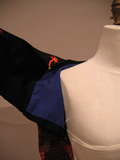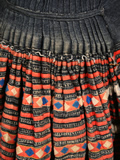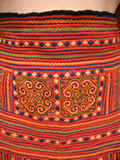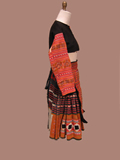The Hmong Ensemble is a woman’s garment composed of a traditional skirt, jacket and apron. The one seen below in Figure 1 has been put together from some older elements and some modern ones which means that it has been reconstructed from some traditional garments and methods but that it also some anachronomisms.
Figure 1: Ensemble |
 |
The skirt, or tab in the Hmong language, is a colorful piece that extends a little lower than the knees. The bright colors indicates that this ensemble may most likely be of Blue Hmong origin because the White Hmong more often wore heavily pleated tabs that were unadorned. This specific tab contains many Hmong stylistic elements, such as pleats, batik pattern, cross-stitching, and appliqué.
Figure 2: Detail of Tab (Skirt) |
Figure 3: Detail of Sev (Apron) |
 |
 |
One of the main features of both the Hmong tabs consisted of two forms of pleats -- knife and accordion pleats. The knife pleats were used at the waistline in order to gather much of the fabric and avoid bulk. The accordion pleats were placed directly below the knife pleats on the garment (at the start of the striped batik pattern), and are very similar to the knife pleats. They both contain two layers of folds facing the same direction, with the outside fold visible and the inside fold hidden.
The second stylistic element present in the tab is the batik pattern used to dye parts of the garment. The pattern begins with an indigo-dyed set of knife pleats, which immediately transitions into the accordion pleats; approximately 3 inches of the accordion pleats are solidly indigo-dyed, which then transitions to a more intricate pattern. After the solid-indigo, the blue and red striped pattern begins and continues until it is interrupted by a stripe of blue and white diamonds. In the Hmong culture, symbols serve as a method of communication, as well as a way for certain desirable attributes (strength, prosperity, etc.) to come into fruition in the lives of those who adorn the clothing. As part of the skirt’s striped pattern, diamonds were used, which were a representation of Earth and its seasons, according to most sources. This symbol is very important to the Hmong Peoples, because many of their daily activities were tied to Earth and its seasons, therefore to embody it in their clothing created a spiritual connection for the Hmong.
Below the batik pattern of the skirt, the final horizontal pattern consists of a meticulous cross-stitch in yellow, white, and red. To accomplish these ornate cross-stitched patterns, the embroider chose to travel behind the fabric to avoid visible stitching irregularities on the right side of the fabric. The square cross-stitched sub-panels contained sun-like and cross-like depictions that were consistent with Hmong symbolism.
Figure 4: Wrong Side of Embroidery |
 |
The horizontal pattern also contains large appliquéd pieces with a color scheme similar to the rest of the garment. In addition to diamonds within the appliqué, it is also important to highlight the triangular patterns that seem to resemble a mountain range, home of the Hmong, which serve as a symbol of strength.
Figure 5: Appliqué at bottom of Tab |
 |
Hmong women dedicate an extensive amount time to the creation of the tabs that they wear. Some of the unfinished nature of this garment may be because the embroiderer was not finished with all of the elements.
The cotton fabric used on the front that juxtaposes the polyester cotton used on the back. The pieces that have been replaced and/or reinforced are made of polyester cloth which was not a typical fabric used. An additional contemporary element used in the Hmong sev is the metallic braid embroidered onto it. It is likely that these elements were added in order to add more adornment to the ensemble which also includes a floral pattern which is not traditional.
The third and final piece that completes the Hmong ensemble is the embroidered jacket, or the tsho. The tsho of this ensemble is a relatively short jacket as can be seen in Figure 6 below. It would extend just below the woman’s bosom. Even though this would seemingly expose the woman’s stomach, the under garments and the belt that are typically worn above the waist would cover this void.
The sleeves of the tsho are similar to that used in the sev and tab. The tsho also contains metallic braids in addition to an identical blue, yellow, and red striped pattern that is periodically interrupted by symbolic embroidery, such as a vertical row of diamonds (once again representing Earth and its seasons) and mountains (a symbol of strength). The rectangular panels of intricate embroidery, which are present in both the sev and tab, are also present in the tsho.
Figure 6: Tsho (Bodice) |
Figure 7: Detail of Tsho Sleeve |
 |
 |
The needlepoint-stitched panels on the sleeves depict fishhooks and elephants’ feet. Fishhooks are characteristic of women's clothing, especially when seeking a husband. Silver balls were attached along the side of the tsho to serve as a closure. They help close the jacket and therefore maintain modesty when it is worn. Because these silver balls and the braided elements used to latch onto them were sewn on to the polyester bodice, it is possible they were after the garment was originally created. It is likely that the silver balls may very well be from the original garment, but just reinstalled. The polyester bodice is a newer addition to the tsho, just as the polyester backside of the sev. A polyester bodice in the presence of an ensemble that is typically composed of cotton or hemp indicates that the bodice may have been restored with polyester to maintain the integrity of the jacket. The cotton sleeves, however, appear to be from the original garment, and were able to preserved and reused.
This Hmong ensemble is more than just clothing. Through the embroidered symbols and patterns within the garment, a woman is able to express herself and her values, as well as her skills and attributes, while maintaining the functionality of the ensemble. Without each piece complimenting the other two, the garment would be incomplete, unable to fully synthesize and depict what the Hmong woman sought to communicate and express.
© Malik Reives, 2017 (text and illustrations)








